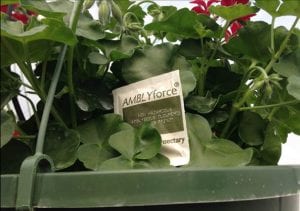 These small paper “envelopes” are slow release “sachets” that contain beneficial predatory mites that attack young thrips larvae. (Thrips are very small insects (1-2 mm. long) with narrow bodies and fringed wings. As they feed they can deform flowers, leaves and shoots. Thrips are primarily a greenhouse pest and not a major pest in the home garden.)
These small paper “envelopes” are slow release “sachets” that contain beneficial predatory mites that attack young thrips larvae. (Thrips are very small insects (1-2 mm. long) with narrow bodies and fringed wings. As they feed they can deform flowers, leaves and shoots. Thrips are primarily a greenhouse pest and not a major pest in the home garden.)
More greenhouse growers are using biological controls to manage thrips. These sachets for the hanging baskets consist of bran, whitish food storage mites (that feed upon the bran) that are a food source for the small beneficial predatory mite Neoseilus (Amblyseius) cucumeris commonly referred to as “cucumeris”. Cucumeris is a beige predatory mite (less than 1 mm. long) that attacks thrips larvae on the leaves and flowers. They pierce the thrips larvae and suck out their contents, killing them. The sachets serve as a breeding system or “nursery” for the beneficial predatory mites which then emerge from the sachets over a 4 week period.
Slow release sachets are now available as mini-sachets for individual hanging baskets. They are best placed in the plant canopy so they are protected from bright sunlight. If the mini-sachets are placed in bright sunlight, high temperatures and low relative humidity adversely affects the reproduction of the predatory mites. The small mites do not travel far and cannot fly, so a sachet is placed in each hanging basket.
The moral of the story – leave the envelope in your hanging basket, and enjoy the flowers!
(By the way, they do not contain fertilizer.)